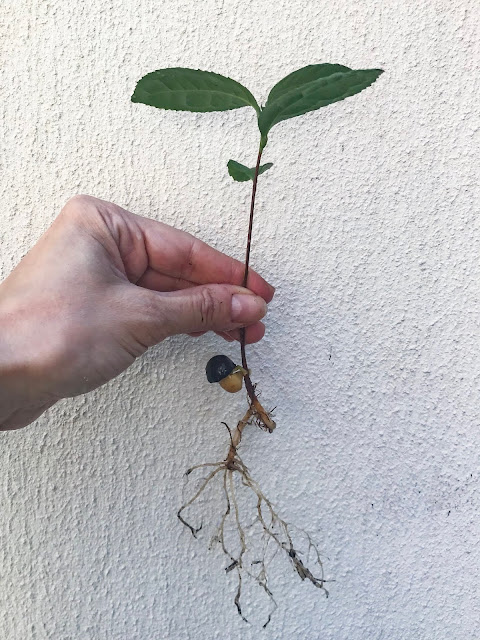I've been growing tea at home, and my little camellia sinensis seedlings are ready for the great outdoors. The seedlings are nice and established so it's time to get them outside, and in larger pots. Spring is here, and the weather is perfect for planting.
I decided to bring most of my plants outdoors, and keep a few in larger pots inside. In making all the preparations I've learned quite a few important things I wanted to share. Before your plants make the big move, here are things to consider:
When To Make The Move
Once your little seedlings have a few established leaves and are about 8 inches tall, they are ready for the great outdoors, or at least a larger indoor pot. Most gardening tips suggest to make the move either in early spring or fall. I germinated my seeds in late august, and now that it's April they are ready for their new surroundings.
Location
Just like inside, you'll want a location that gets them as much sunlight as possible. If you are planting in the ground, you'll want an area big enough to make sure you have 2-3 feet in between each plant. The soil needs to also be well-draining. Don't choose an area where the water ends up pooling, and sitting around. I'm keeping some of my outdoor plants in pots, and some planted in a large plant bed on my patio. I have a few permanently indoors as well, using the same parameters as I used in my first post.
 |
| check out those roots! |
Type Of Pot
At first I wanted really nice looking pots since this could be a permanent home for some of the plants. But once I was at the store, I realized how heavy the large terracotta and other clay pots were. In reality, I needed something I could easily move around, as I'm planning on bringing the potted plants back inside once the weather gets frosty. I ended up choosing sturdy plastic pots for ease of use.
When looking for pots, you'll need to know how big your root ball is. You'll want something about twice the size of the root ball in order to give the roots sufficient room to keep growing. But you won't want the pot to be bigger than this, since the roots may not be able to find enough water.You'll also want to try and find a pot that's 1.5 inches deeper than it is wide (for example, if the pot is 12 inches wide, make sure it's 18 inches deep). Whatever you choose, it's essential to make sure there are drainage holes in the pots.
Soil
If you are planting in pots, you'll want to use the same type of soil as I mentioned before, something well-draining. You can use orchid mix, cactus mix, or regular potting mix with a bit of sand added in. If you are planting outdoors, make sure the soil drains well, and is slightly acidic. It's easy to add acidity to the soil through a mix such as this, or fertilizer like this one.
It's Time To Replant
Now that the weather has warmed up (make sure temps are in the 40s and above at night) and you have everything ready, it's time to get replanting. First off, before you leave those little plants outside full time, they need to get used to their new temperature and environment. You'll need to do what's called 'hardening off'. Let me explain:Every day for a few hours, bring the plants outside (in their existing pots), and let them adapt to the new environment. They need exposure to sun, wind, rain, and temperature. You should do this for about a week before keeping them outside permanently. Experts say to do this gradually, a few hours the first day, then adding an hour or two for each progressive day. But honestly, I just left my little plants outside all day, bringing them inside around sunset. They did just fine.
When the plants are ready to be transplanted, make sure you are gentle! Getting the plants out of the existing pots can be a little difficult if the roots are well established. Be sure to gently loosen the plant from the soil, so you don't damage any of the delicate roots. They've worked so hard to grow, you don't want to cause any unnecessary stressors to the plant now.
 |
| Some of my plants are still happily indoors |
After replanting, be sure to give the plants a good drink of water. But you'll want to make sure they have sufficient water without overwatering. I know that's confusing, but you'll need to change your watering habits based on the climate. If it hasn't rained in a few days, check the soil. If it's very dry, be sure to water. Also, if it's the middle of the summer and temps are super hot, you may need to water every day. Just use good judgement and your plants will be very happy.
I decided to keep a few plants permanently indoors, to see how they do compared to the outdoor plants. I'm guessing they won't grow as heartily, but I'm also worried about how well the outdoor plants will do once winter comes. There is a process to protect the plants from harsh winter weather, but I first need to learn all about it. That'll be an upcoming post, for sure.
For tea growing basics to get you started, visit my first post about growing camellia sinensis at home. For the next steps, visit my part 3 post here. If you have any questions about these tips for repotting your tea plants, feel free to leave a comment below! If you've had success growing tea plants, I'd love to hear about your tea-growing adventure.



No comments:
Post a Comment